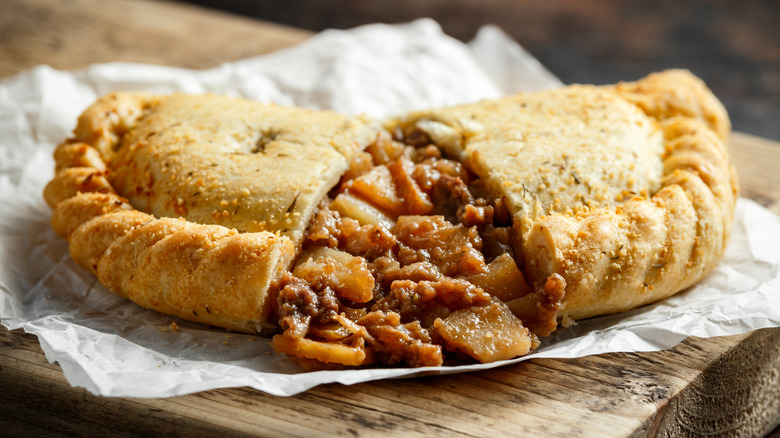The Difference Between Empanadas And Cornish Pasties Is In The Filling
There are certain categories of food that seem to be nearly universal in their application: things on sticks, things in sauce, and things wrapped in dough. In the latter category, we have dishes ranging from Jamaican beef patties (here's our recipe) to South Asian samosas (again, we've got a recipe) to Polish pierogies (yup, got a recipe for these, as well). Two particularly popular pies are empanadas, which may be Spanish in origin but are known throughout Latin America, and Cornish pasties, which, as the name implies, were created in Cornwall. They are now emblematic of Michigan's Upper Peninsula, as well.
So what differentiates these two types of savory pastry? Well, for one thing, there's the crust, since empanada dough may be made with masa harina in addition to flour and might also contain some sugar. Cornish pasty crust, as specified by the Cornish Pasty Association, mustn't be sweet and can only consist of shortcrust (aka standard pie dough) or puff pastry. Pasties are typically baked, as well, whereas empanadas can be fried. Still, it's what's on the inside that really counts, and again, you'll find that empanadas and Cornish pasties are just as different when it comes to their fillings as they are with their exteriors. While empanadas can showcase a broad array of meats and sweets, Cornish pasties follow a much stricter set of guidelines.
Empanadas can be filled with just about anything
No matter what your food preferences may be, there may be an empanada for you, as these come in such a wide variety of fillings. In Argentina, traditional beef empanadas often include both green olives and raisins, while chicken empanadas are made with bell peppers. Peruvian empanadas often include boiled eggs and olives in addition to meat flavored with aji amarillo paste, while Bolivian empanadas, aka salteñas, are filled with a meaty stew. Moving north of the equator, we find Colombian empanadas filled with meat and potatoes, or sometimes just simply potatoes, while cheese-filled fried empanadas are a popular Mexican street snack.
Dessert empanadas, too, are also a thing. In El Salvador, empanadas may be made using mashed, sugared plantains as the dough and stuffed with a creamy milk filling, while guava paste and cream cheese are used to fill sweet Costa Rican empanadas. Apple empanadas, while they may sound like an all-American spin on this dessert, are actually taking the dish back to its roots as empanadas de manzana is something that's served up in Spain.
True Cornish pasties, on the other hand, must be filed with a very specific mix
Cornish pasties, as regulated by the Cornish Pasty Association, must fulfill very specific requirements before they can be sold under that name. For starters, just as Champagne can only be produced in that region, so must Cornish pastries be assembled and baked in Cornwall. We've already covered the crust, but the stuffing, too, is strictly set out: Each filling must be made up of at least 12.5% meat, while vegetables must make up no less than 25%. As for the former, only beef will do, and this must be chopped or ground (minced being the British term). The only permissible vegetables are potatoes, onions, and swedes. No actual Swedish citizens are harmed in the making of this dish, however (bork, bork, bork!), as this last word refers to the vegetable that we in the U.S. call rutabagas.
In Michigan, which is admittedly outside the geographic boundaries for its pasties to merit the Cornish designation, the pasty was introduced by copper miners who arrived from Cornwall in the late 19th century. The pasties, for the most part, adhered pretty closely to the traditional version, with one notable exception. The Finnish miners who came to the Upper Peninsula after the Cornish ones were already established adopted the pasty as their own but used carrots in place of rutabagas. To this day, many UP bakeries either specialize in Cornish or Finnish styles or offer both types of pasty.


